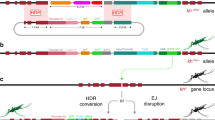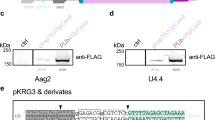Abstract
Anopheline mosquito species are obligatory vectors for human malaria, an infectious disease that affects hundreds of millions of people living in tropical and subtropical countries. The lack of a suitable gene transfer technology for these mosquitoes has hampered the molecular genetic analysis of their physiology, including the molecular interactions between the vector and the malaria parasite. Here we show that a transposon, based on the Minos element1 and bearing exogenous DNA, can integrate efficiently and stably into the germ line of the human malaria vector Anopheles stephensi , through a transposase-mediated process.
This is a preview of subscription content, access via your institution
Access options
Subscribe to this journal
Receive 51 print issues and online access
$199.00 per year
only $3.90 per issue
Buy this article
- Purchase on Springer Link
- Instant access to full article PDF
Prices may be subject to local taxes which are calculated during checkout

Similar content being viewed by others
References
Franz, G. & Savakis, C. Minos, a new transposable element from Drosophila hydei, is a member of the Tc1-like family of transposons. Nucleic Acids Res. 19, 6646 (1991).
Loukeris, T. G., Livadaras, I., Arca, B., Zabalou, S. & Savakis, C. Gene transfer into the medfly, Ceratitis capitata , with a Drosophila hydei transposable element. Science 270, 2002–2005 ( 1995).
Coates, C. J., Jasinskiene, N., Miyashiro, L. & James, A. A. Mariner transposition and transformation of the yellow fever mosquito, Aedes aegypti. Proc. Natl Acad. Sci. USA 95, 3748–3751 (1998).
Jasinskiene, N. et al. Stable transformation of the yellow fever mosquito, Aedes aegypti, with the Hermes element from the housefly. Proc. Natl Acad. Sci. USA 95, 3743– 3747 (1998).
Berghammer, A. J., Klingler, M. & Wimmer, E. A. A universal marker for transgenic insects. Nature 402, 370–371 ( 1999).
Catteruccia, F. et al. Toward Anopheles transformation: Minos element activity in anopheline cells and embryos. Proc. Natl Acad. Sci. USA 97, 2157–2162 ( 2000).
Chalfie, M., Tu, Y., Euskirchen, G., Ward, W. W. & Prasher, D. C. Green fluorescent protein as a marker for gene expression. Science 263, 802–805 (1994).
Cormack, B. P., Valdivia, R. H. & Falkow, S. FACS-optimized mutants of the green fluorescent protein (GFP). Gene 173, 33–38 (1996).
Klinakis, A. G., Loukeris, T. G., Pavlopoulos, A. & Savakis, C. Mobility assays confirm the broad host range activity of the Minos transposable element and validate new transformation tools. Insect Mol. Biol. (in the press).
Miller, L. H. et al. Stable integration and expression of a bacterial gene in the mosquito Anopheles gambiae. Science 237, 779–781 (1987).
Loukeris, T. G., Arca, B., Livadaras, I., Dialektaki, G. & Savakis, C. Introduction of the transposable element Minos into the germ line of Drosophila melanogaster. Proc. Natl Acad. Sci. USA 92, 9485–9489 (1995).
Pinkerton, A. C., Michel, K., O'Brochta, D. A. & Atkinson, P. W. Green fluorescent protein as a genetic marker in transgenic Aedes aegypti . Insect Mol. Biol. 9, 1– 10 (2000).
Tamura, T. et al. Germline transformation of the silkworm Bombyx mori L. using a piggyBac transposon-derived vector. Nature Biotechnol. 18, 81–84 ( 2000).
Kumar, V. & Collins, F. H. A technique for nucleic acid in situ hybridization to polytene chromosomes of mosquitoes in the Anopheles gambiae complex. Insect Mol. Biol. 3, 41–47 (1994).
Acknowledgements
We thank A. Richman at EMBL for the initial efforts for anopheline transformation and D. Prager and the MacArthur Vector Biology Network for the collegial interactions that greatly stimulated the project. The research was supported by a Network grant of the training and Mobility Program of the European Community, by Implyx Ltd, by WHO-TDR, by the John D. and Catherine T. MacArthur Foundation, the SFB 544 of the Deutsche Forchungsgemeinschaft and an individual fellowship of the Biotechnology Program of the EU (T.G.L.)
Author information
Authors and Affiliations
Rights and permissions
About this article
Cite this article
Catteruccia, F., Nolan, T., Loukeris, T. et al. Stable germline transformation of the malaria mosquito Anopheles stephensi . Nature 405, 959–962 (2000). https://doi.org/10.1038/35016096
Received:
Accepted:
Issue Date:
DOI: https://doi.org/10.1038/35016096
This article is cited by
-
Hidden genomic features of an invasive malaria vector, Anopheles stephensi, revealed by a chromosome-level genome assembly
BMC Biology (2021)
-
Is Saglin a mosquito salivary gland receptor for Plasmodium falciparum?
Malaria Journal (2019)
-
Anopheline antiplatelet protein from mosquito saliva regulates blood feeding behavior
Scientific Reports (2019)
-
A synthetic male-specific sterilization system using the mammalian pro-apoptotic factor in a malaria vector mosquito
Scientific Reports (2019)
-
Molecular tools and genetic markers for the generation of transgenic sexing strains in Anopheline mosquitoes
Parasites & Vectors (2018)
Comments
By submitting a comment you agree to abide by our Terms and Community Guidelines. If you find something abusive or that does not comply with our terms or guidelines please flag it as inappropriate.



